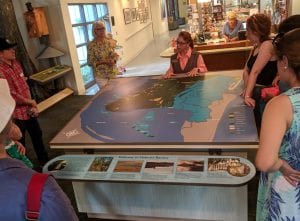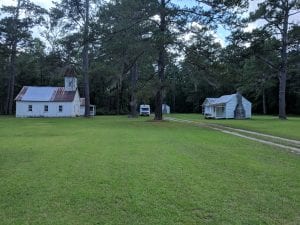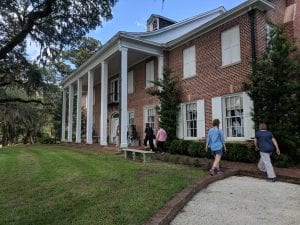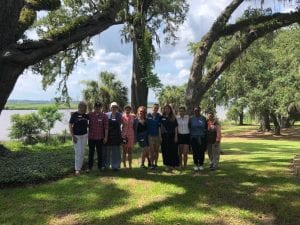Between the Waters: A Northerner’s Epiphany About Sense of Place
What does it mean to be a steward of material culture?
This is a question I found myself asking constantly at every place we visited during our Southern field study in June. We asked our hosts and guides this question in myriad ways, and many places struggled with the same things: how to get visitors to imagine what life was like for its inhabitants, how to guide visitors’ paths through an institution or across a bustling and architecturally diverse city. In short, how to make their institution’s collections and spaces relevant to the 2018 visitor.
Of all the incredible places we visited, Hobcaw Barony struck me more than any other. Owned by the Belle Baruch Foundation, Hobcaw Barony is protected by the Foundation’s endowment and primary mission to “conserve Hobcaw Barony’s unique natural and cultural resources for research and education” (http://hobcawbarony.org/about-hobcaw/). This is no easy feat considering that Hobcaw Barony comprises 16,000 acres—a peninsula equivalent in size to the island of Manhattan!

Our guide, Lee Brockington, shares the expanse of Hobcaw Barony with the Class of 2019. The dark green in the center of the board represents the peninsula that makes up Hobcaw, and the light blue represents former rice fields when Hobcaw was a rice plantation.
During our visit, our guides Lee Brockington and Janet Krapels explained the importance of the ecological riches at Hobcaw. Universities have ecological research facilities on the property to study everything from coastal Carolina plant life to loggerhead sea turtles. With land maintenance costs covered by the Belle Baruch Foundation, Hobcaw Barony continues to provide a place for environmental research and education for students from first grade to graduate school. However, Hobcaw Barony also contains over 70 cultural sites including archaeological evidence of Native American presence, 19th-century dwellings at Friendfield Village and other sites where enslaved Africans and African Americans resided while working on the rice plantation, and the Baruch family residence overlooking the river and Georgetown, South Carolina. Unlike many of the other institutions we explored that week, the Belle Baruch Foundation does not provide much funding for the preservation and interpretation of these cultural sites. This revelation compelled our main question for Lee and Janet: how do they protect these cultural sites if the Foundation does not provide complete financial support? Staff and supporters of Hobcaw are actively seeking creative solutions to this challenge.

Some of the buildings at Friendfield Village that remain standing. The Village was where enslaved Africans and African Americans lived while they worked at Hobcaw Barony’s rice plantation, and where servants lived after the Civil War who continued to work there. When the Baruch family purchased Hobcaw Barony in 1905, some of these people continued to live here. Lee Brockington shared some incredible stories with us about visitors who remembered living at Hobcaw or visiting relatives here at Friendfield Village in the mid-20th century. The dwellings on the right side were homes, while the dwellings on the left were a church and the doctor’s house behind it.
My biggest takeaway from Hobcaw Barony was the opportunity to experience an amalgamation of cultural sites occupying one location over centuries. While not all the structures at Hobcaw Barony remain standing, walking around Friendfield Village or the Baruchs’ 1935 mansion gives visitors a unique sense of place and space. As I thought through Lee’s and Janet’s answers about Hobcaw Barony’s future as a cultural organization, I realized it may have been the best example of environment-as-material-culture that I have seen. Saving the peninsula was a wise and unique accomplishment which many cultural institutions are unable to achieve. While reliant on grants and private donations to maintain the cultural sites sitting on the land, Hobcaw’s interpreters like Lee and Janet illustrate the tangible impact of sense of place in the study of material culture.

The WPAMC Class of 2019 walks into the Baruch family home, built in 1935. Although Bernard Baruch first bought Hobcaw Barony in 1905, he did not have a house constructed for the family until 10-20 years later. This house was built in 1935, after their first home burned in a fire in the 1920s. Belle Baruch often wrote and spoke about how Hobcaw Barony was her favorite place, and even had a house built elsewhere on the property so she could live there in her own space rather than with her parents.

The marshes at Hobcaw Barony are home to myriad wildlife, from tidal oysters to egrets. Our third and final stop with Lee, this area is used primarily for ecological research, but it gives visitors a renewed sense of both the size of Hobcaw Barony and its significance located so close to Charleston.
As a steward of material culture, I now have a deeper understanding of place thanks to Hobcaw Barony. Environment is just as much material culture as the buildings, artifacts, and objects that sit upon it or under the dirt. For this New Englander’s first trip south of Williamsburg, VA the experiences offered by coastal South Carolina both surprised and motivated me to continue thinking beyond objects. Material culture is not simply about the tangible ceramics, or furniture, or even architecture; it is about preserving and sharing a sense of place, acknowledging the entire story of a location to help visitors understand and accept not only our story, but the stories of the land with which we coexist.

The WPAMC Class of 2019 with interpreters Lee Brockington and Janet Krapels opposite the Baruch house in front of the river and Georgetown, SC in the background. Janet surprised us when we arrived at the Baruch house in her University of Delaware shirt—Class of ’76! Thanks to Belle, Lee, and Janet, I will be able to approach my future work in material culture with a better understanding of what it means to be part of a place, not just a product of it.
By Katie Fitzgerald, WPAMC Class of 2019

Leave a Reply